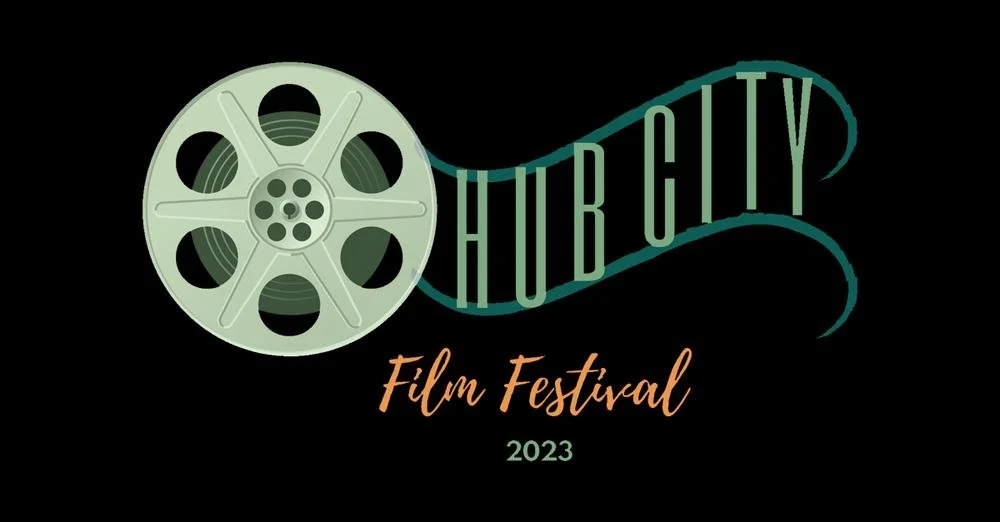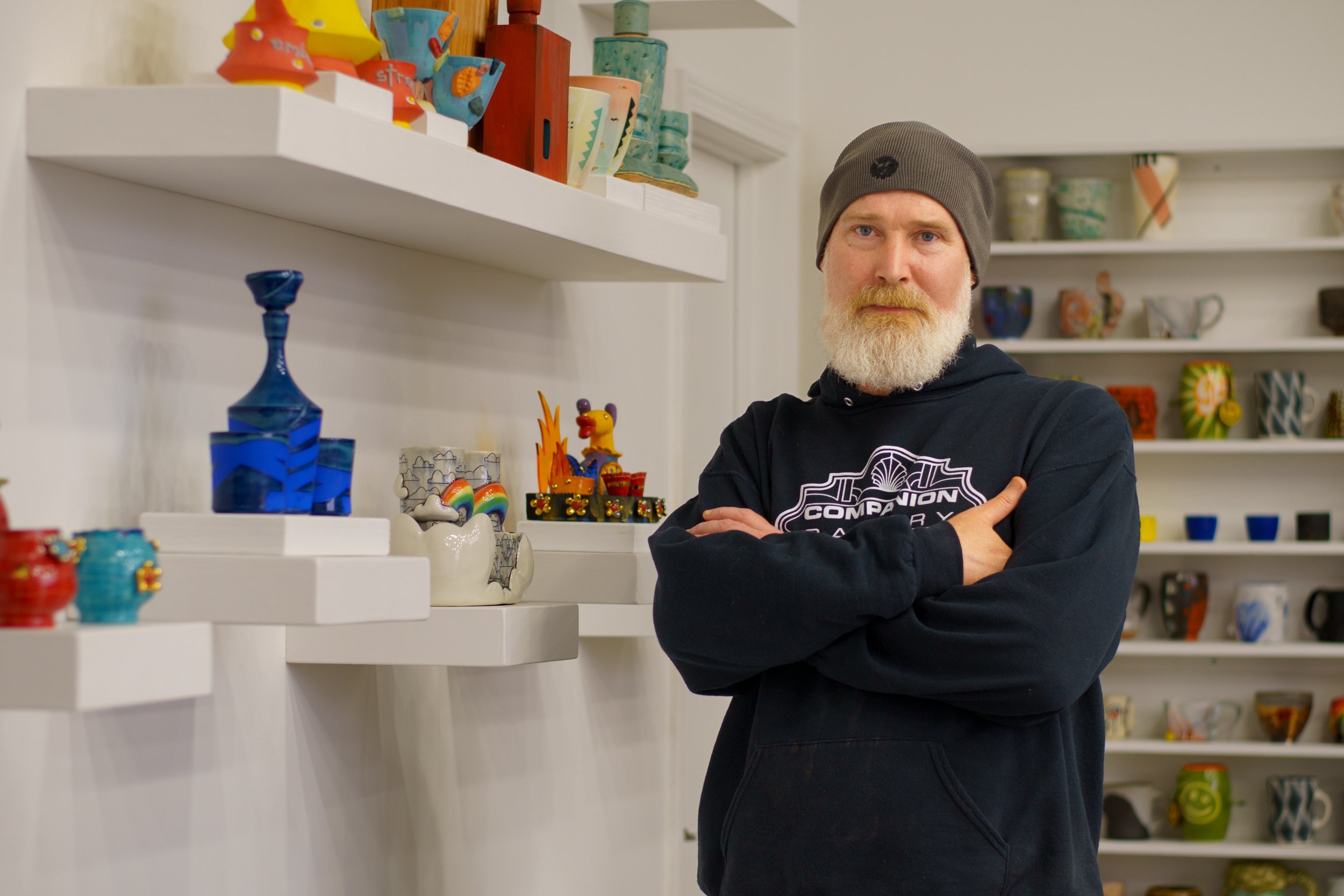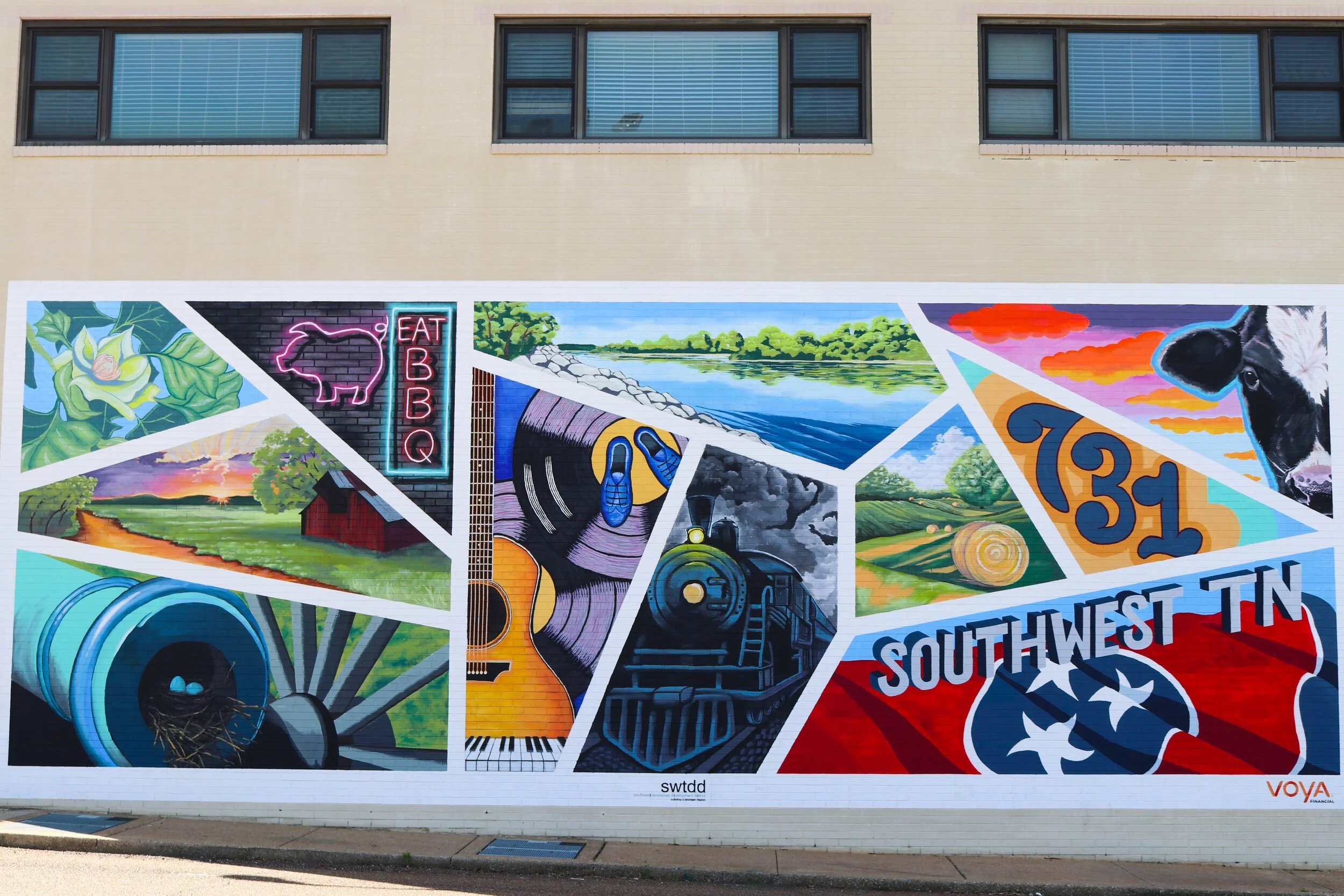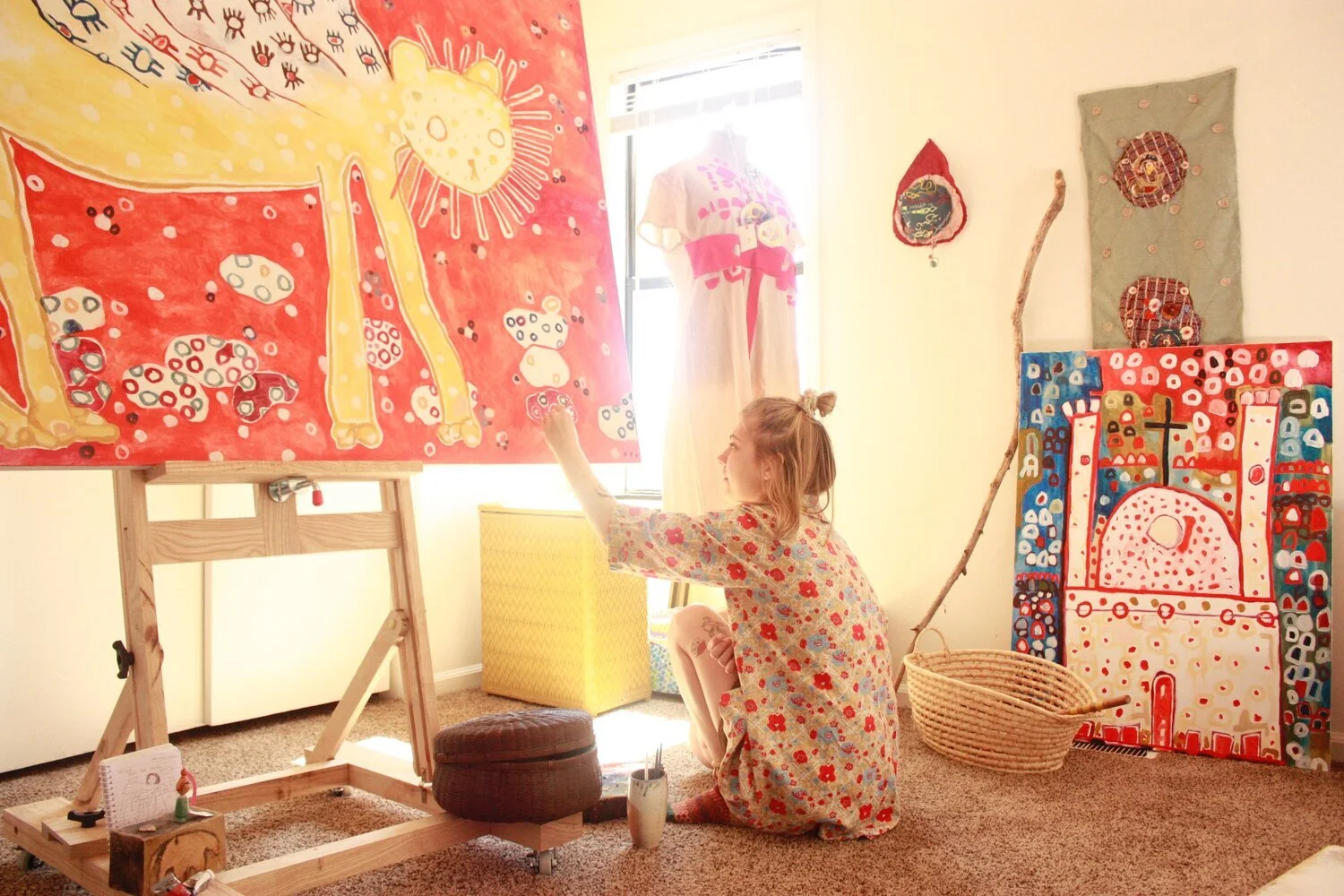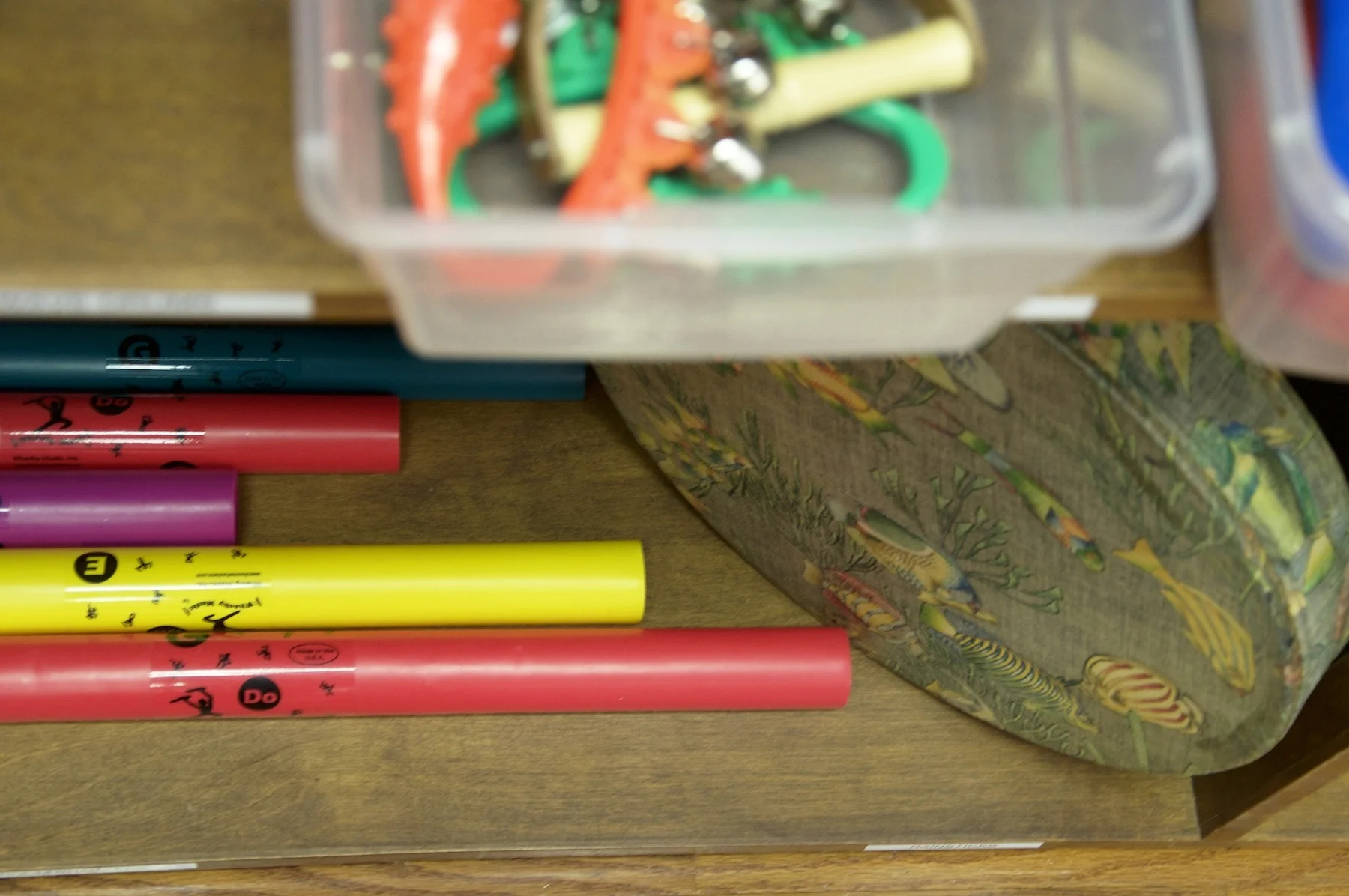Fresh Paint : Public Art in Uncertain Times
This piece was originally published in the December 2019 - March 2020 issue of our journal, Vol. 5, Issue 3: Pioneers.
There are plenty of conversations about what art is and isn’t, who it is and isn’t for. I’m interested in this conversation, but I can’t answer that question, unless I answer it for myself.
This September, I painted a mural that is now one of the first things to greet you when you arrive in downtown Jackson. Nestled just past Grubb’s Grocery and the Jackson Walk on North Highland, it’s a bright and idyllic scene, and I’m not oblivious to the fact that it’s an even more idealistic message: Love your neighborhood.
Driving in from the opposite direction, there’s another scene set as you approach historic downtown. To your left, the criminal justice building and the imposing, windowless walls of the jail addition being built. On the right, Hope Café (a function of Hope Recovery Center) and the Neely House, housing the fine dining establishment, Chandelier Restaurant.
This is our neighborhood. Full of philanthropists and entrepreneurs. Full of poverty and addiction. Full of love, growth, and possibility.
I have, as an artist, wondered if painting bright colors on a wall is trivial in the midst of the world as it is right now. I don’t know very many people who aren’t stricken at some point by the thought that things might be better if only they could be somewhere else doing something else. So many of our conversations are spent on talking about the things that people have elsewhere, shaking our heads and muttering, “Jackson,” like it’s some sort of curse. Our complaints range from the frivolous (I for one, wouldn’t mind a few more brunch options) to the serious. I also don’t know very many people who haven’t for a moment had to face the question of whether or not the place we live can sustain the kind of life we dream of.
Sister Corita Kent was an art professor for Immaculate Heart College in Los Angeles, California. She made a well-known list of rules for art students, including the first rule: “Find a place you trust and try trusting it for a while.” I like this rule because it feels true, to my own experience at least. This mural was a product of testing that rule, deciding to trust this place for these first five years of my life and career after college.
“Find a place you trust and try trusting it for a while.”
Corita wrote about the duty of an artist in society, and explained that our creative endeavors are important because the act of making reflects the universal act of imagining and putting our abilities to use to better our world, whether we’re mothers or lawyers or poets. All of our hope does no good in our heads. We have to do the work. She writes, “To dream about a painting and not also to work at it doesn’t ever bring about a painting. To dream about creating a new world that is not teetering on the edge of total destruction and not to work at it doesn’t make a peaceful world. So it is important that we are creative people working daily on the greater picture as well, bringing to it all our skills of imagination and making.”
Following the completion of my project, the Mayor’s office announced the beginning of their public art campaign, and the first project to follow that announcement was by nine-year-old Ava Pugh. Ava’s work is painted on a utility box at the corner of East Main and Lafayette, in front of the county courthouse, depicting unity through three figures with their hands raised, clasped together.
I chose the concept for my mural based on the words of the Mister Rogers’ Neighborhood theme song that asks, “Won’t you be my neighbor?” Later in that same song, he says, “I have always wanted to have a neighbor just like you. I have always wanted to live in a neighborhood with you.” I can’t help but think that Ava’s artwork speaks more purely about that than I ever could.
In a recent commencement speech to Judson University graduates, artist Makoto Fujimura spoke about this same transformational power, and it may explain why a resurgence of art in our community may walk hand in hand with healing and transformation for all of our neighbors. He described the trauma of current affairs, saying, “Yours is a traumatized generation, with bullet holes in schools still causing flashbacks every time there is an ‘active shooter drill.’ You are numbed by never-ending terrorist threats and brutalities and images of destruction all over the news. You grew up with metal detectors at sports games and concerts and other ‘new normals’ of our fear-filled age.”
“Your lives can be an offering of peace in a divided time—a gesture of hope for those in despair.”
He then introduced the ancient Japanese practice of Kintsugi, mending broken teacups with gold, the cracks becoming valuable and beautiful.
“Your generation will mend and pour gold into the fissures of our broken times,” he said. “And you cannot only mend; you can create anew, create a world in which an invitation will be given to those who are broken. Those who mourn, those who are persecuted, and those who are poor in spirit will be offered a great light. Your lives can be an offering of peace in a divided time—a gesture of hope for those in despair.”
There are a lot of other reasons to create art, but maybe we’re on to something here. Maybe filling in the cracks is a good place to start. I think of the revolving photo gallery curated by Aaron Hardin on the corner across the street from ComeUnity Café, taking an empty building and using the storefront windows to make the striking and thought-provoking images accessible to anyone walking by. Maybe these small acts of beauty and color—of images that speak to us and begin conversations—are enough to restore our vision of what we thought a place could be.
I’m reminded that when I first stood facing the wall where the mural now stands, I saw peeling paint and a task that felt too daunting to someone who’d never painted anything large scale. But after months of planning, the work took shape. It’s a product of friends and neighbors who offered encouragement when I wanted to step back in fear. It’s a product of the building owner Forrest Hall for being willing to let a stranger paint his business; of donations of paint from PPG Paints; of my friends Heather Lutz, Annalise Bennett, and Blake Marlar spending an evening scraping paint off; of Leo Galan being willing to prime the wall at the last minute when it required more preparation than I’d expected; of Madison Borden hanging in there with me through a weekend of climbing ladders and painting in an intense September heatwave; of strangers passing by to offer kind words; of leadership in the Jackson Chamber, JDDC, the mayor’s office, and Visit Jackson TN being willing to put funding into the hands of people ready to use their gifts to better their communities. It’s a product of all of us.
Maybe in some small way, our effort to peel back some old, chipped paint and create something new is a step towards the larger work to be done in our community—finding the places where there is division and doing the work of mending and restoring.
Check out more of Courtney’s work on her website.
Courtney Searcy is the Program Director of Our Jackson Home at theCO. Jackson became home after she graduated from Union University in 2014, where she studied Graphic Design and Journalism. She thinks the best things in life are porch swings, brunch, art, music, and friends to share it all with.
Cari Griffith is a photographer by trade who loves storytelling of all kinds. After a couple of years away in Nashville, she and her husband Rob decided Jackson was calling them home, and they moved back to their beloved Lambuth area neighborhood. Cari's other loves include gardening, cooking, sharing meals with her friends, and trying to talk Rob into getting a dog.













